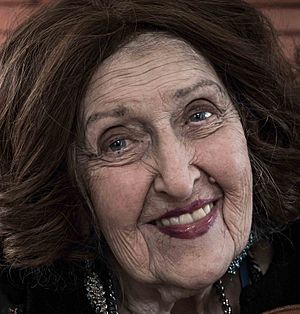Ida Haendel facts for kids
Ida Haendel (born December 15, 1928 – died July 1, 2020) was an amazing Polish-British-Canadian violinist. She was a true child prodigy, meaning she had incredible talent from a very young age. Her career as a musician lasted for more than 70 years! She also became a very important teacher, inspiring many other violinists.
Contents
Early Life and Amazing Talent
Ida Haendel was born in 1928 in a town called Chełm, in Poland. Her family was Jewish. Her talent for music was clear when she was only three years old. She picked up her sister's violin and started playing!
She won major music competitions that helped her become famous. When she was just five years old, in 1933, she won the Gold Medal at the Warsaw Conservatory. She also won the first Huberman Prize for playing the Beethoven Violin Concerto.
At age seven, in 1935, she competed against very famous violinists like David Oistrakh. She became a prize-winner at the first Henryk Wieniawski Violin Competition.
These wins allowed her to study with two highly respected teachers: Carl Flesch in London and George Enescu in Paris. During World War II, she played music in factories and for British and American soldiers. She also performed in special concerts at the National Gallery in London.
In 1937, she made her first big performance in London. A famous conductor named Sir Henry Wood led the orchestra. Her playing was so good that he compared it to another legendary violinist, Eugène Ysaÿe. Ida Haendel performed many times at the famous Proms concerts, appearing 68 times!
A Global Performer
In 1949, Ida Haendel played the Sibelius Violin Concerto in Helsinki, Finland. The composer, Jean Sibelius, was so impressed that he sent her a letter. He wrote, "You played it masterfully in every respect. I congratulate myself that my concerto has found an interpreter of your rare standard."
Ida traveled every year to perform in Europe. She also played regularly in South America and Asia. From 1952 to 1989, she lived in Montreal, Canada. She often performed with Canadian orchestras and became a well-known musical star there. She became a Canadian citizen while still being a British subject.
In 1973, she performed with the London Philharmonic Orchestra in China. She was the first Western musician invited to play there after the Cultural Revolution. She worked with many famous conductors throughout her career. Some of them include Sergiu Celibidache, Sir Thomas Beecham, Otto Klemperer, Zubin Mehta, and Sir Simon Rattle. With Sir Simon Rattle, she recorded the violin concertos by Elgar and Sibelius.
In 1993, she played with the famous Berliner Philharmoniker orchestra for the first time. In 2006, she performed for Pope Benedict XVI at the former Nazi concentration camp Auschwitz-Birkenau. She also played at a tribute concert in London and a festival in Italy in 2010. Ida Haendel played a very special violin made by Stradivarius in 1699. For many years, she lived in Miami, Florida, and was involved in the Miami International Piano Festival.
Making Music: Her Recordings
Ida Haendel made many recordings that were highly praised by music critics. In 1982, the Sibelius Society gave her the Sibelius Medal. She always said she loved German music.
Her recording career started on September 10, 1940, with the Decca record label. She first recorded short solo pieces and chamber music. In 1945, she recorded the Tchaikovsky and Mendelssohn concertos. In 1947, she recorded the Dvořák concerto. Her recording career lasted almost 70 years, working with major labels like EMI and Harmonia Mundi.
In 1948–49, she recorded Beethoven's Violin Concerto with the Philharmonia Orchestra. In 2014, a company called Supraphon released a 5-CD set of her live and studio recordings from Prague.
Other famous recordings include her performances of the Brahms Violin Concerto and the Tchaikovsky concerto. A music critic named Geoffrey Norris praised her 1993 recording of the Sibelius concerto as "simply mind-blowing." Later, she recorded the famous Sonatas and Partitas for Solo Violin by J. S. Bach in 1995.
She also loved music from the 20th century, including works by Béla Bartók and Benjamin Britten. She performed new pieces for the first time, like Luigi Dallapiccola's Tartiniana Seconda. She also played Allan Pettersson's Violin Concerto No. 2, which was written just for her. In 2000, her recording of George Enescu's Violin Sonata with Vladimir Ashkenazy won a special award called the Diapason d'Or.
Inspiring Others: Her Teaching
Ida Haendel's emotional and powerful performances inspired many new violinists. Some famous musicians she influenced include Anne-Sophie Mutter, David Garrett, and Maxim Vengerov.
In August 2012, she was an honorary artist at the Cambridge International String Festival. She often served as a judge for violin competitions, including the Sibelius and Carl Flesch competitions. She returned to her home country of Poland many times to judge the Henryk Wieniawski Violin Competition. In 2011, she was the honorary chairwoman of the competition.
Later Life and Legacy
Ida Haendel passed away on July 1, 2020, at the age of 91, in Pembroke Park, Florida.
In 1991, Queen Elizabeth II made her a Commander of the Order of the British Empire (CBE). This is a very special honor. She also received honorary doctorates from the Royal College of Music in London in 2000 and from McGill University in 2006.
Her life story has been featured in several television documentaries. These include Ida Haendel: A Voyage of Music (1988) and Ida Haendel: This Is My Heritage (2011). In 2009, she appeared on a TV show called The World's Greatest Musical Prodigies. On the show, she gave advice to a young composer about choosing children to play his music.
See also
 In Spanish: Ida Haendel para niños
In Spanish: Ida Haendel para niños


